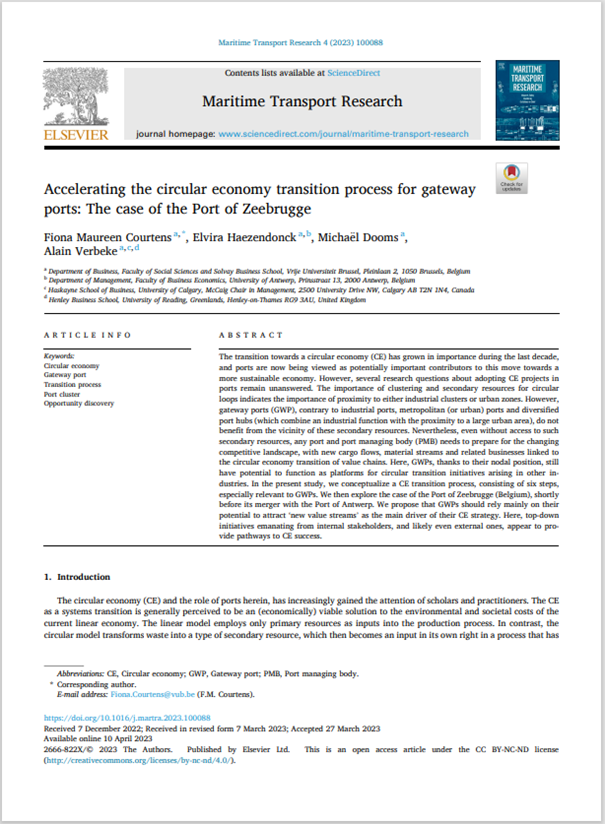Identifying and pursuing circular initiatives in gateway ports (GWPs) is challenging and largely unexplored. A VUB-ECSA case study of the port of Zeebrugge (BE) shows that GWPs have the potential to act as platforms for circular economy (CE) initiatives from other industries. GWPs should rely on their potential to attract ‘new value streams’ as the main driver of their CE strategy. Here, top-down initiatives from internal and likely external stakeholders appear to provide pathways to CE success.
Circular economy challenge for gateway ports
Haezendonck and Van den Berghe (2020) studied the different development patterns of circular initiatives in ports and found that the importance of clustering and secondary resources for circular loops indicates the importance of proximity to either industrial or urban activities.
Gateway ports (GWPs), unlike industrial ports, metropolitan (or urban) ports and diversified port hubs (which combine an industrial function with proximity to a large urban area), do not benefit from the proximity of these secondary resources (See Figure 1: Port typology). However, even without access to such resources, every port and port management body (PMB) needs to prepare for the changing competitive landscape with ‘new value streams’, material flows and related businesses linked to the circularity of value chains. Here, GWPs still have the potential to act as platforms for circular transition initiatives emerging in other industries, thanks to their nodal or hub position in transshipment cargo.

Figure 1: Port typology according to the vicinity of industrial clusters and urban areas
Source: Composed by authors, based on Faut et al. (2022). Circular Port Monitor. Explorative Research: Toward First Actionable Insights. Report commissioned by Circular Flanders and produced by ECSA, VUB, PLA.
Pathways to accelerate circular initiatives
The development of CE initiatives requires stakeholders to identify a business opportunity, and then the same or different stakeholders to commit to making this opportunity a reality. This process of identification and implementation can be influenced at different macro, sectoral or organizational levels. Two approaches to initiative development seem to prevail, depending on whether the main stakeholders are internal or external to the port itself (See Figure 2: Circular economy project development)
In the case of internal stakeholders, a further distinction can be made between a top-down or orchestrated approach (emanating from the PMB) and an organic bottom-up approach (emanating from port users).
External stakeholders can also play an important role in identifying the CE opportunity. This third party may be a government agency, a sectoral organization or a company that is not currently active in the port, but which inspires port users to seize the opportunity.

Figure 2: Circular economy project development
Source: Composed by authors, based on Verbeke, A. and Yuan, W. (2022). Rethinking intrapreneurship in the established multinational enterprise. Strategy Journal. PU: Port User; PMB: Port Management Body
Gateway port of Zeebrugge as a relevant case
In early 2021, a study was commissioned by Circular Flanders/Flemish Public Waste Agency (OVAM) to explore the possibilities for the gateway port of Zeebrugge (before the official merger with the port of Antwerp) to initiate (more) circular initiatives in the port area. The study focused in particular on the potential of the Carcoke site, a former industrial site (6 ha) that was the subject of a ‘blackfield’ site remediation project (See Box: Flanders’ blackfield approach) in the Zeebrugge port area. OVAM, as the public owner and financer of this very costly remediation project, also has a regulatory mandate to engage in a ‘conditional return’ of the site to the PMB (which would then supposedly grant new lease concessions to port users).
Flanders’ blackfield approach
The Flemish Brownfields Decree makes the remediation and redevelopment of contaminated (industrial) sites economically interesting. But what happens if the site is so contaminated that remediation costs more than the intrinsic value of the land, making private initiative impossible? In this situation we speak of ‘blackfields’ and the government intervenes.
The Flemish Public Waste Agency (OVAM) has developed a set of instruments for blackfields, including the possibility of acquiring such sites for a symbolic 1 euro. As the owner of the site, OVAM can solve the soil and waste problems on these sites as efficiently and effectively as possible. It can recover some of the public funding invested by selling the site after remediation.
In recent years, OVAM, together with other government partners, has sought to maximize the (interim) spatial reuse of such brownfield sites, and especially as a lever to stimulate a future-oriented (circular) redevelopment from a broader social interest.

The former Carcoke blackfield site in the port area of Zeebrugge before OVAM’s remediation started in 2002.
For the Zeebrugge case study, the VUB-ECSA research group developed a process-based pathway (6-step model within the CE identification process) to identify and subsequently engage with CE initiatives in ports, with a particular focus on GWPs:
- Identify supply-side boundary conditions for targeted CE initiative discovery.
- Define demand-side boundary conditions for targeted CE initiative identification using benchmark activities in other port areas.
- Match the dual boundary conditions (1 and 2) with the available sites in the port area under consideration.
- Assess the economic promise of CE initiative prospects that may involve port users.
- Identify ‘coalitions of the willing’ around promising CE initiative prospects.
- Match available sites (3) with the most promising CE initiative prospects (4 and 5) in the port.
(For details, read the full paper)
Orchestrating ‘coalitions of the willing’
The benchmarking of CE activities in other neighboring leading ports (step 2 of the case study) shows that the current activities in these ports do not require substantial space and also tend to transport rather small volumes via hinterland waterways, at least so far. This suggests that GWPs with a limited area and a mainly transshipment role could still be successful in identifying and implementing CE opportunities.
A critical condition for success appears to be a top-down or orchestrated approach by either the PMB or a key external stakeholder, where the port strategy has evolved to include a CE transition component. This approach deserves further attention and complements the more conventional organic bottom-up CE development by the port users themselves. More specifically, in the Zeebrugge case study, pressure from an ‘external stakeholder’ (i.e. OVAM as the public authority, owner and remediator of the Carcoke site) was instrumental in legitimizing the very idea that CE could flourish in a gateway port area and in changing the attitude of the PMB towards recognizing the potential value of CE initiatives.
In the case of Zeebrugge, external pressure from an outside public actor on the port management body was crucial in legitimising the very idea that potential circular initiatives could flourish in the port.
Based on their experience, the researchers suggest an additional step as a transition between the identification of CE opportunities and their implementation: Orchestrating ‘coalitions of the willing’ by co-creating pathways for implementation and scale-up with different stakeholders. The findings are based on a case study, namely that of the port of Zeebrugge, but the process approach used here may to some extent be applicable to other types of port areas seeking to participate more actively in the CE transition. PMBs may also play a more prominent role in other GWPs, as the CE transition will certainly lead to changes in the competitive port landscape in the future.
Read the full paper on the Zeebrugge case study
This article is based on the academic paper ‘Accelerating the circular economy transition process for gateway ports: The case of the Port of Zeebrugge‘, which was published online on 10 April 2023 in the journal Maritime Transport Research.
All references can be found in the full paper.
Cite as: Courtens, F. M., Haezendonck, E., Dooms, M., & Verbeke, A. (2023). Accelerating the circular economy transition process for gateway ports: The case of the Port of Zeebrugge. Maritime Transport Research, 4, [100088]. https://doi.org/10.1016/j.martra.2023.100088
Corresponding author: Fiona.Courtens@vub.beacademic




